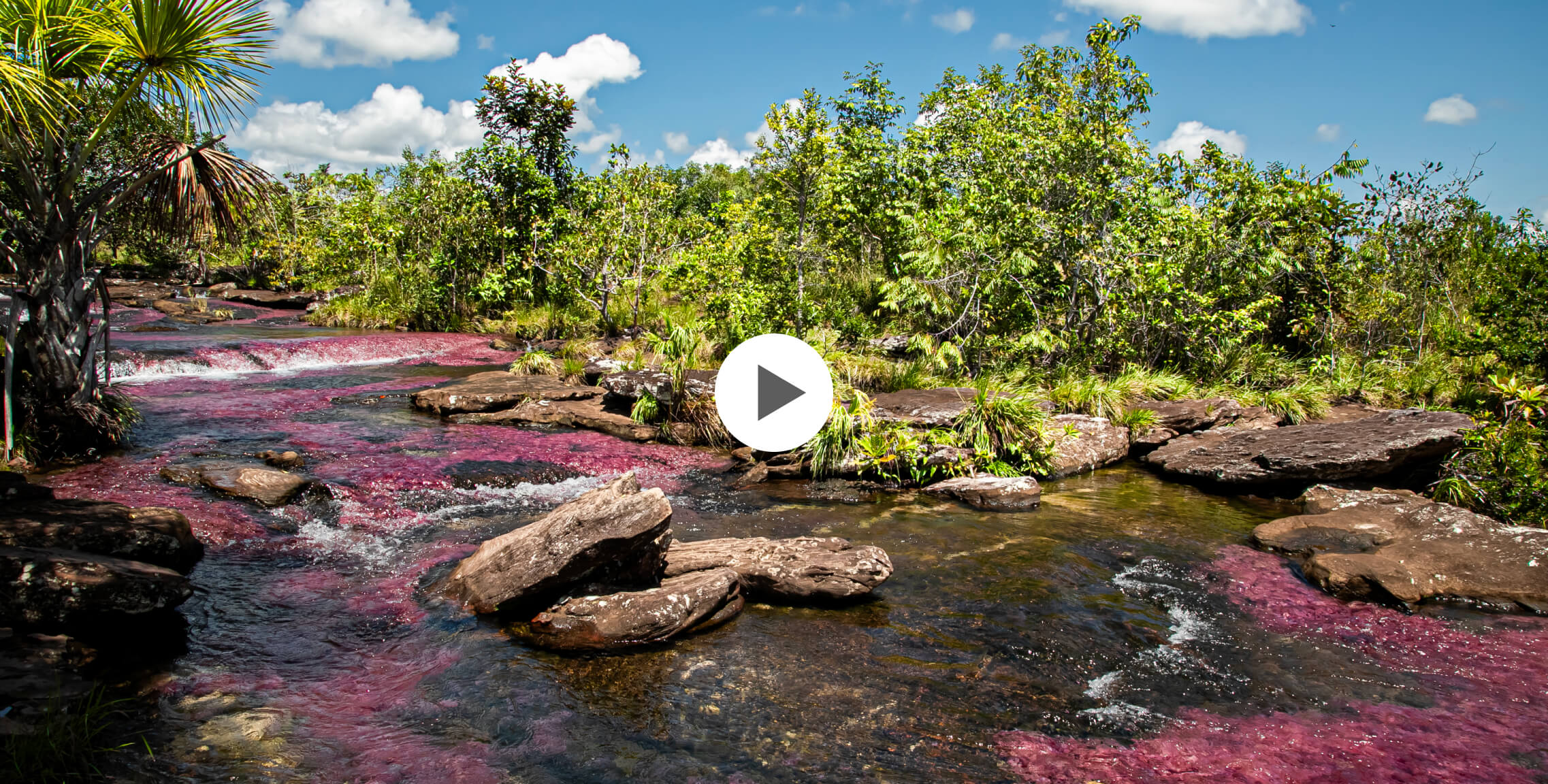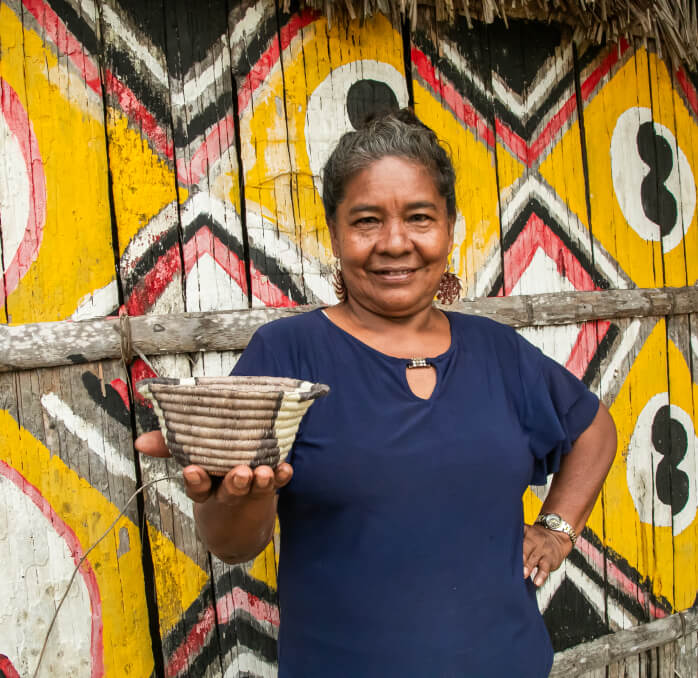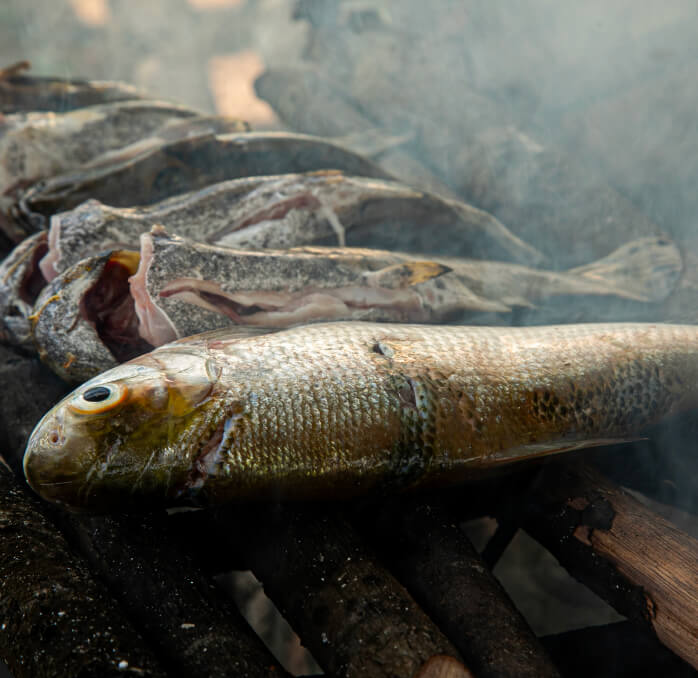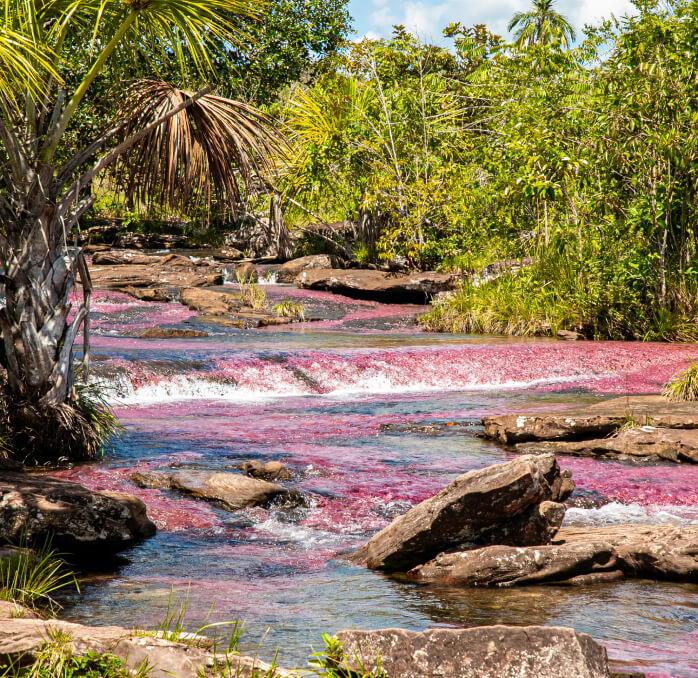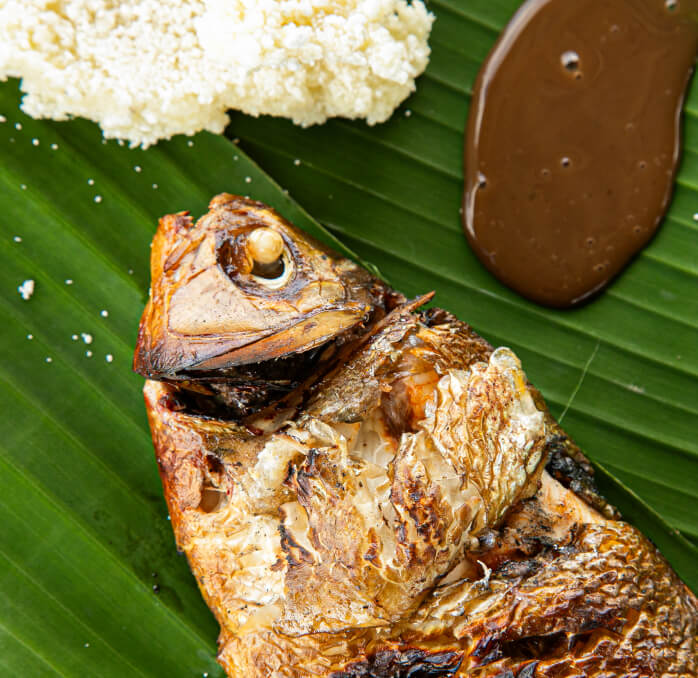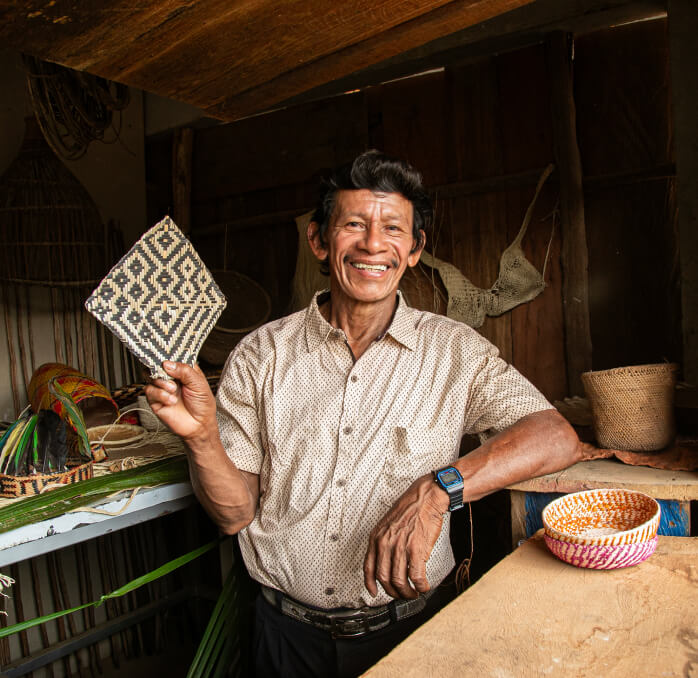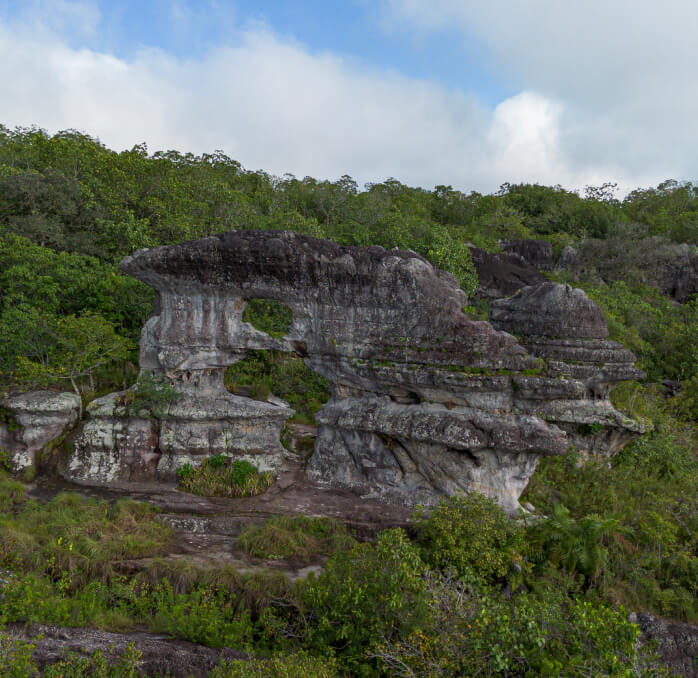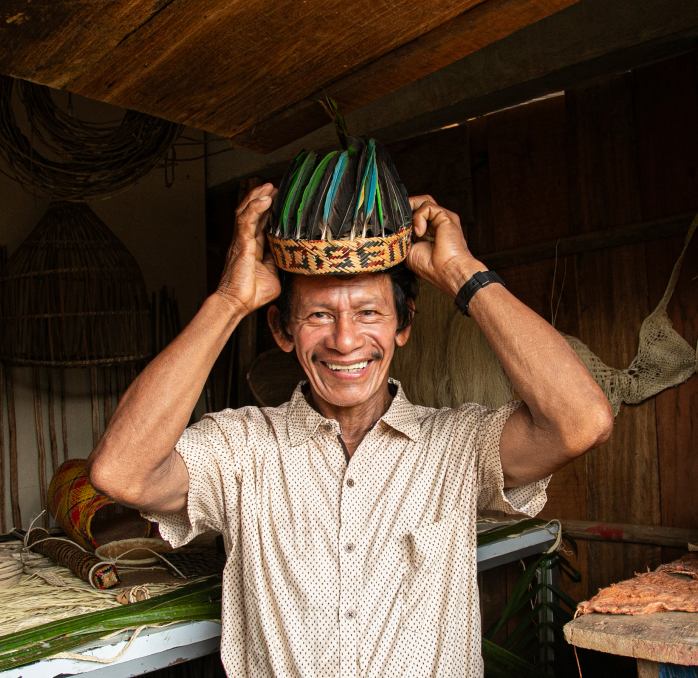Guaviare Route
Despite having been a department struck by its recent history of violence, it is worth shifting our perspective and viewing Guaviare with hopeful eyes to appreciate the peaceful beauty of its ancient landscapes and meet its people, who open their renewed doors to us. The grandeur of time that traverses Guaviare, shaping its terrain—tepuys, bridges, and stone wells that for millennia have been influenced by water and wind—also serves as canvases for cave paintings dating back over twelve thousand years. Therefore, witnessing the landscapes and natural attractions of this department confronts us with the truth of our own scale. Faced with the width of its rivers and the magnitude of its ecosystems, encompassing the Orinoco, mountain ranges, and the Amazon, we can only accept and appreciate our finiteness.
Today, Guaviare is a diverse department where people from all over the country coexist alongside ethnicities that historically inhabited the region or arrived from Brazil during the rubber boom. In this multiethnic and multicultural setting, you can witness how the fruits of the earth are utilized by those who preserve and nurture a knowledge as ancient as the territory itself. From the reserves where they currently reside, craftsmen and craftswomen weave palms of cumare, moriche, and warumá, preserving their culture through their crafts, native languages, prayers, dances, and cuisines. Arlety Quiróz, of Tariana descent, will enlighten you about her Brazilian heritage and showcase her bags, baskets, and hats made from cumare. Francisco Castañeda, an enthusiastic artisan proud of his Jiw culture, specializes in crafting cumare backpacks and warumá kitchen utensils. Meanwhile, Esteban Rodríguez, a Curripaco artisan, is well-versed in the various types of baskets woven from warumá used to process and prepare bitter cassava. Irene Vasconcello, of the Tukana ethnicity, has dedicated herself to exploring cumare to make bracelets, bags, jewelry boxes, and earrings. Lastly, Maria Alves, a craftswoman of the Cubeo ethnicity, awaits you in the southern part of the department, dedicating herself to weaving cumare on her laurel loom.
You can reach Guaviare by road or by air, and the focal point of this route will be its capital, San José del Guaviare. From there, you can visit indigenous reserves and the department’s main natural attractions: the Natural Wells, Tranquilandia resort, the stone city of San José, natural bridges, El Diamante de las Aguas Natural Reserve, and the Puerta de Orión. Don’t miss the rock paintings at Cerro Azul and Nuevo Tolima, and if you visit in August, attend the International Yurupary de Oro Festival, a folkloric event featuring various artistic activities, poetic gatherings, and dance performances. During this festival the URUTÚ Departmental Indigenous Handicraft Fair is held, featuring all ethnic communities of the department and special guests (craftsmen and entities from the country). Note that the dry season runs from January to June, and the rainy season from July to December. The rainy season is the best time to enjoy the rivers, although access to some of the shelters where our artisans reside may be affected. Don’t miss trying the smoked fish, casabe, moriche chicha (fermented drink), and for dessert, garza pudding.
Embark on a journey full of history
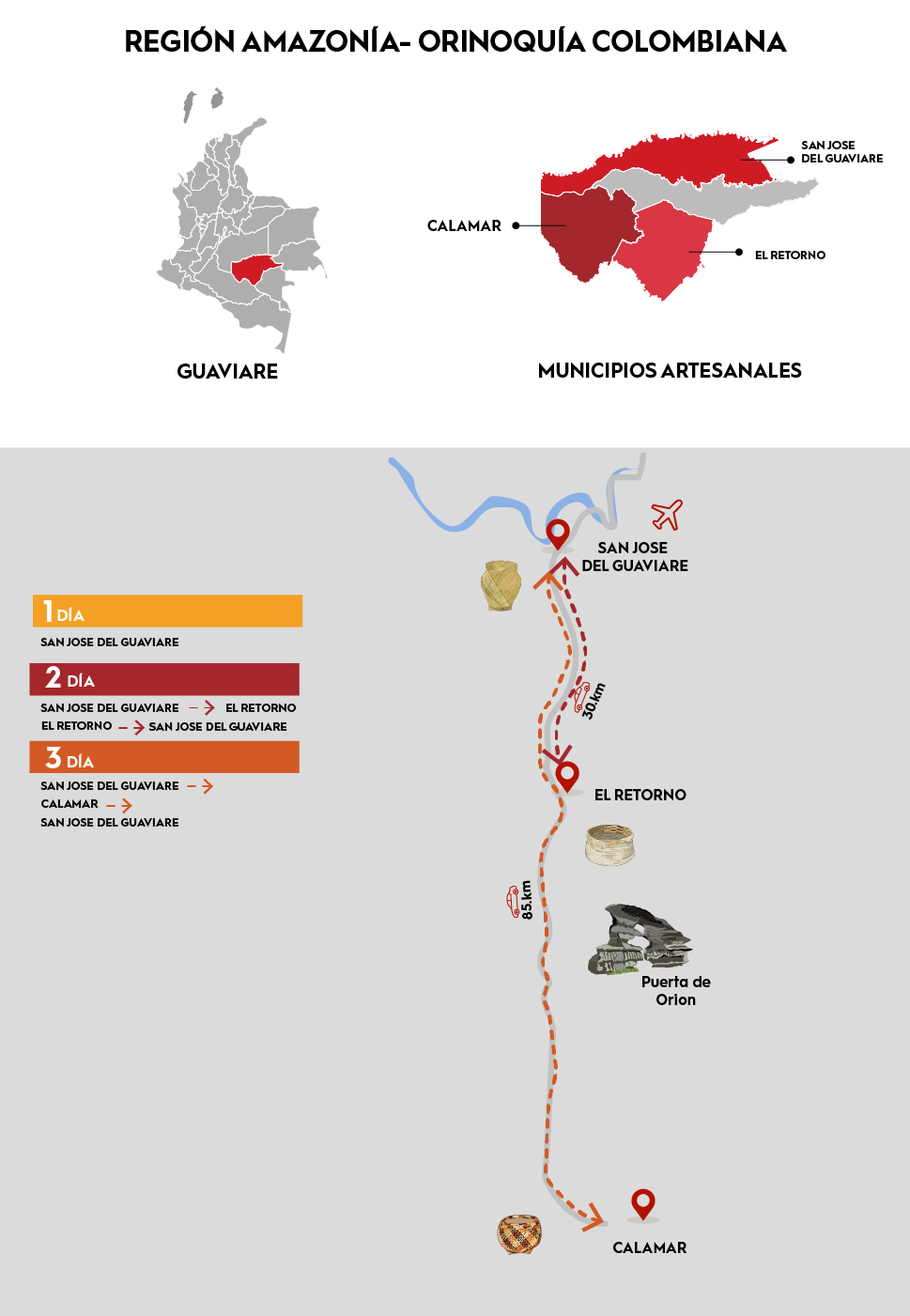
Artisans along the way
Artisans along the way
We recommended this tour
Schedule the visit in advance with the artisans.
Carry cash
Travel in summer season (January - June)
Carry hydration
Bring repellent
Wear long sleeve shirts and long pants
You have to pay a tax when leaving Guaviare
If you want to visit Irene Vasconcello in Asunción, go in January by motorcycle
3 days
Car or Bus
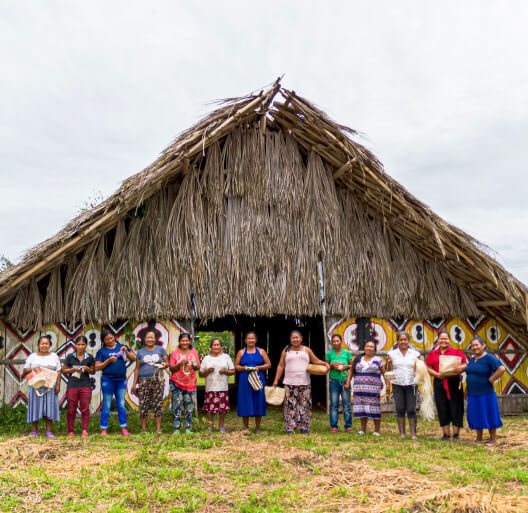
San José del Guaviare — El Refugio — El Barrancón — San José del Guaviare
Embark on the Guaviare route by visiting Arlety Quiroz, a Tariana artisan working with cumare fibers in El Refugio, east of the capital. Heading further east to El Barrancón, meet Jiw artisan Francisco Castañeda, who works with cumare and warumá. After getting an introduction to the crafts of this department, return to San José for lunch at El Dorado Restaurant and catch the sunset from the Nowen Bridge. Spend each night in San José del Guaviare.
San José del Guaviare — El Retorno — La Asunción — San José del Guaviare
On the second day, head south and visit Esteban Rodríguez in El Retorno, half an hour from San José. This Curripaco artisan possesses extensive knowledge of weaving warumá utensils used to process bitter cassava. After immersing yourself in his stories and legends, travel 19 kilometers south to La Asunción. Here, you’ll meet Irene Vasconcello, a Tukana weaver working with cumare. We recommend contacting Irene days before your visit to arrange a typical lunch and enjoy a slow-cooked smoked fish or muñica, a delicious fish soup with chili. After the feast, return to San José to rest.
San José del Guaviare — Calamar — San José del Guaviare
On your final day meeting the department’s artisans, head to Calamar, a municipality 75 kilometers from San José. Here, you’ll meet María Alves, an artisan of the Cubeo ethnicity skilled in cumare weaving. She learned to use the loom through a friendship, and you’ll appreciate the quality and delicacy of her products when you visit.
San José del Guaviare
Now, surrender to adventure and enjoyment as you discover Guaviare’s wonders. Visit the iconic eroded rock formation of Puerta de Orión, 21 minutes from San José, and walk to Tranquilandia, where you can have lunch, explore its colorful algae river, and bathe in its crystal-clear natural pools. Return to San José to enjoy the sunset at Laguna Negra and rest.


San José del Guaviare
Near San José and El Diamante de las Aguas Natural Reserve, you’ll find the Natural Wells. Reserve the morning to explore, wade through its streams waist-deep, and bathe in its stone pools and waterfalls. In the afternoon, visit the Túneles Naturales Reserve and explore its impressive rock formations on the way to the Stone City, concluding the day’s adventure.
On your last day, choose between Cerro Azul or Vereda Nuevo Tolima. In either of these locations, you’ll witness Guaviare’s best-kept secret: cave paintings dating back over twelve thousand years, adorning the stone walls of the tepuys, rock formations of the Guiana Shield. Immerse yourself in their mesmerizing red tones and symbols, testament to the antiquity and significance of these lands. Return to San José for lunch at KAKURI, an Amazonian cuisine restaurant, and begin your return journey.
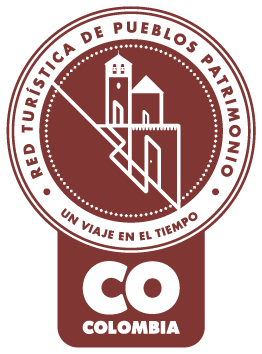
Pueblo Patrimonio
La Red Turística de Pueblos Patrimonio de Colombia es un programa especial del Ministerio de Comercio, Industria y Turismo, ejecutado por FONTUR, que trabaja con 17 municipios de Colombia que poseen declaratoria de Bien de Interés Cultural (BIC) a nivel nacional para su valoración y proyección mediante el turismo, generando así más oportunidades de desarrollo y sostenibilidad en las comunidades.

La Medalla a la Maestría Artesanal es un galardón que Artesanías de Colombia entrega anualmente, con el cual se hace un reconocimiento a aquellos artesanos, empresas y comunidades artesanales que, contando con una trayectoria destacada, sobresalen a nivel nacional por su excelencia en el oficio así como por preservar el quehacer artesanal.

Denominación de Origen
Es un signo distintivo que identifica productos reconocidos o famosos por tener una calidad o características específicas derivadas esencialmente del lugar de origen y la forma tradicional de extracción, elaboración y producción por parte de sus habitantes. La protección conferida sobre una Denominación de Origen implica que ninguna persona puede identificar con la denominación protegida productos iguales o similares a los amparados, cuando no provengan del verdadero lugar y no cumplan con las características o calidades que le han dado la reputación al producto reconocido. Las Denominaciones de Origen para productos artesanales colombianos que han sido protegidas por la Superintendencia de Industria y Comercio en nuestro país son actualmente 12.
No puede copiar contenido de esta página








































